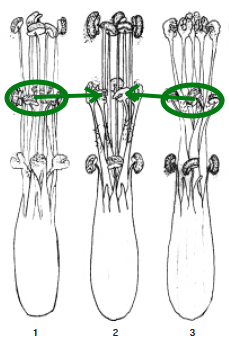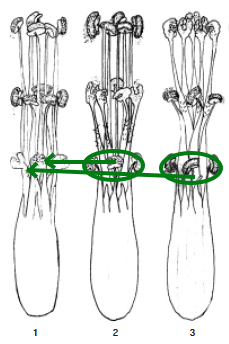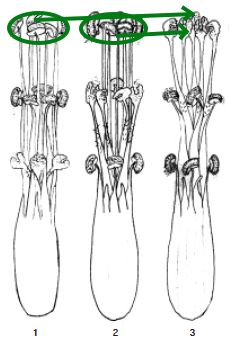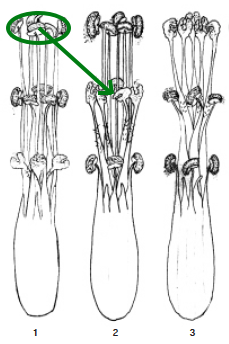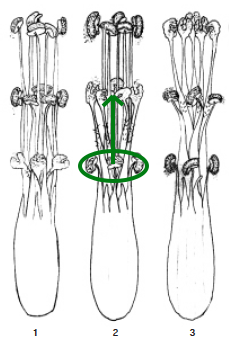Blog, breeding, oca (Oxalis tuberosa)
Oca: Maximizing seed yield of crosses
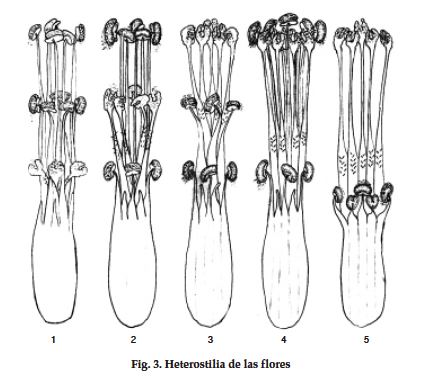
When my oca (Oxalis tuberosa) began to flower, I set out to learn as much as possible about crossing, since I was aware that oca has a rather complicated tristylous incompatibility system. In brief, that means that it has three types of flowers, each bearing two types of stamens, each one of which corresponds to another of the flower types. The two types of stamens and the styles form three tiers and pollinations between stamens and styles from the same level are considered legitimate, while those that cross tiers are considered illegitimate.
A picture helps. In the diagram, have a look at the flowers labeled 1, 2, and 3. (We’ll ignore 4 and 5, as they are unusual flower forms.) Flower 1 is short-styled; there are two tiers of stamens above the styles. Flower 2 is mid-styled; there is a tier of stamens both above and below the styles. Flower 3 is long-styled; there are two tiers of stamens below the styles.
This is the sort of subject where lots of visual aids and examples can be a big help, so I recommend that you also read the excellent articles on this topic at Radix and Growing Oca.
With that orientation, we can now take a look at the possible combinations for successful pollination. All of the information that I am summarizing here comes from Germplasm conservation of oca (Oxalis tuberosa Mol.) through botanical seed. Seed formation under a system of polymorphic incompatibility by Trognitz et al, Euphytica 101: 133-141, 1998. I’ll be simplifying things quite a bit, so if you want the full story, you should get your hands on the article.
As noted above, there are three “legitimate” pollinations for oca. These generally produce the most viable seed. That is not the full story, but it is a good place to start.
Figure 1a shows the legitimate pollinations of a mid-styled oca flower. The possible crosses are represented as (M x mS) and (M x mL); that is mid-styled x middle stamen of a short styled flower and mid-styled x middle stamen of a long-styled flower, respectively. If you wanted to create one of these crosses, you would simply take the stamens in the green ovals and rub them against the styles that the arrows are pointing to.
Long-styled and short-styled pollinations work in exactly the same fashion, just shifting up or down one tier as appropriate:
Legitimate Pollinations
I’ve shown the rate of seed pod formation and the rate of seed production with each figure. You can use these data to figure out how best to perform crosses with a limited number of oca flowers. For example, if you have short-styled and mid-styled flowers to work with, you are better using the short-styled flower as the female parent (71% seed production) than the mid-styled flower (65% seed production).
There is one additional type of pollination to consider: the self-pollination of mid-styled flowers. If short- or long-styled flowers can self-pollinate at all, the rate appears to be very low. Mid-styled flowers, on the other hand, show some ability to self in the M x sM (Figure 2b) cross. This is not limited to self-pollinations; crosses between two different mid-styled cultivars are also possible.
The above percentages tell you how likely that you are to get some seed in a capsule, but not how much. That is a trickier matter to delve into. I’m not sure what the upper limit is for an oca pod, it appears that the normal case is 15, with three seeds in each of five compartments. It may be possible to get more seeds, since oca sometimes produces hexamerous or septamerous flowers, which could theoretically contain 18 or 21 seeds, respectively. The most that they saw in the study referenced earlier in this post was 16 seeds in a pod. The most that I have seen is 19. The average seeds per pod is also noted with each figure. I have seen significant differences in average seed yield between varieties that bear the same flower type, so I think that there is more to this story.
All of this is great, so long as you have some compatible varieties. Unfortunately, they are not distributed in equal proportions. Mid-styled varieties are probably the most common, followed by short styled, with long-styled varieties in a distant third place. In North America, there are few long styled varieties, four common mid-styled varieties (Amarillo, Blush, Hopin, and White) and the rest are short styled. This situation is changing quickly as we release new varieties and obtain more from other collectors. If you have a bunch of short styled varieties and no mids or longs, is there any hope for seed? The short answer is: probably not. The key to successful oca breeding is having at least one variety that is not short-styled. You shouldn’t have any trouble finding shorts. It would be easy to buy a bunch of oca varieties and end up with all shorts, leaving you wondering why you never get a seed.

